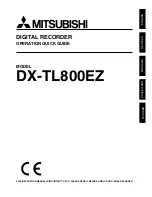
100/180 mm PAPERLESS GRAPHIC RECORDER: USER GUIDE
HA028910
Issue 13 Sep 16
User Guide
Page 16
3.1.3 Alarm indication
This area of the display can contain a number of status icons: Instrument alarm, Channel alarm, Battery
change, Disk status, FTP in progress, Confi guration locked, and so on. Pressing this area of the screen
calls the ‘Summary menu’ (section 3.1.4) allowing the user to view active instrument alarms, to acknowl-
edge all channel alarms, to display the Alarm Summary or Message Log page. Media removal strategy is
also controlled from this pop-up. If the access fl ap ‘Lock’ option is fi tted, see also
section 2.4
.
For channel alarm symbols refer to ‘
Current Trace Alarm Icons
’, above.
INSTRUMENT ALARM
This indicator appears, fl ashing, if any of the following errors are active. The instrument alarm summary
page, described in Section 3.1.4, allows the user to view such instrument alarms as are active.
Active Directory server error
The Active Directory server (
section 4.5.1
) cannot be accessed.
Archive failed -(message)
Message explains archive failure.
Battery-backed RAM cleared
This message appears if the battery has failed, and the unit has
been switched off.
Clock failure
Internal clock was corrupt at power up, or the time has never been
set. Can be caused by battery failure, in which case the battery
icon will also be visible. The error is cleared by setting the time and
date. Server time forced to 00:00 1/1/1900.
Channel error
Indicates a hardware failure in the channel circuit or in the internal
CJ temperature measurement
Channel failure
Indicates a hardware failure in the input channel circuit (see note).
DHCP Server failure
For instruments with IP address lookup set to ‘Get from DHCP
Server’, this alarm occurs if the recorder cannot obtain an IP ad-
dress from the server. See
section 4.5
for details.
FTP Archiving fi le lost
Archive failed. A fi le which has not been archived, has been detected.
FTP Archiving too slow
Remote archive is too infrequent. The recorder effectively switches
to ‘Automatic’ (
section 4.3.5
) to ensure that data is not lost.
FTP Primary Server Failure
This error is set if the recorder fails, after two attempts, to establish
communications with the primary server as defi ned in Archive Con-
fi guration (
section 4.3.5
). After the second attempt has failed, the
Secondary server is tried.
FTP Secondary Server Failure
This error is set if the recorder fails, after two attempts, to establish
communications with the secondary server as defi ned in Archive Con-
fi guration (
section 4.3.5
). See also ‘FTP Primary Server Failure, above.
Insuffi cient non-volatile memory...
There is insuffi cient memory available for the confi guration. Can
be caused by use of Rolling Average maths functions.
Internal fl ash: \application\ required repair Error found in the internal fi le system at power-up, and corrected.
Internal fl ash: \history\ required repair
Error found in the internal fi le system at power-up, and corrected.
Internal fl ash: \screens\ required repair Error found in the internal fi le system at power-up, and corrected.
Internal fl ash: \user\ required repair Error found in the internal fi le system at power-up, and corrected.
Internal fl ash: \user\ is full
Appears if the User partition is full. To clear, either user screens
must be simplifi ed or fi les must be deleted from \User\, or both.
Maths Channel failure
Appears if, for example, the divisor of a divide function is zero.
Media Archiving fi le lost
Archive failed. A fi le which has not been archived, has been detected.
Media Archiving too slow
Archive is too infrequent. The recorder effectively switches to ‘Au-
tomatic’ (
section 4.3.5
) to ensure that data is not lost.
Network boot failure
The recorder is unable to establish connection with the BootP or
DHCP server. This might be caused by, for example, cable failure,
network hardware failure, etc.
Output channel failure
Indicates a hardware failure in the output channel circuit (see note).
Note: Unlike other instrument alarms, Channel Failure and Output channel failure are not self clearing.
Once the cause of failure is rectifi ed, the recorder must be power-cycled in order to clear the alarm.
















































